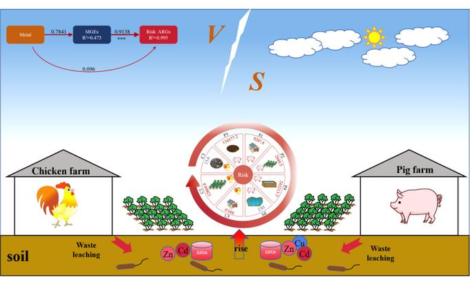



Amino Acid Digestibility in Soybean Products, Rapeseed Expellers and a Fermented Mixture of Co-products for Weaner Pigs
A study at the Hans H Stein Monogastric Nutrition Laboratory at the University of Illinois shows similar digestibility of crude protein and amino acids for all processed soy products tested and these were generally higher than for the rapeseed products tested. A fermented mixed product based on rapeseed had the lowest digestible amino acid content.Soybean meal is the most common source of protein in swine diets in the United States. However, conventional soybean meal contains antinutritional factors such as antigenic proteins, oligosaccharides, lectins and trypsin inhibitors that limit its use in diets fed to weanling pigs.
Methods of processing soybean meal to remove antinutritional factors have been developed. These include enzyme treatment, fermentation, and the removal of soluble carbohydrates.
Like soybean meal, rapeseed products are usually not fed to weanling pigs due to the presence of glucosinolates and relatively high concentrations of fibre in these products.
Previous research has shown that fermentation of soybean meal can reduce antinutritional factors and fiber concentrations. It is possible that fermentation can make double-zero (00)-rapeseed meals and 00-rapeseed expellers suitable for feeding to weanling pigs, but no research has been conducted to confirm this hypothesis.
An experiment was conducted to determine the standardised ileal digestibility (SID) by weanling pigs of crude protein and amino acids in four sources of processed soybean products, conventional soybean meal, conventional 00-rapeseed expellers, and in a fermented mixture of co-products including 00-rapeseed expellers, wheat bran, potato peel, and soy molasses.
Experimental Design
Twenty-seven weanling barrows with an average initial body weight of 9.29kg were surgically equipped with a T-cannula in the distal ileum and fed one of eight diets.
The four processed soybean products were two sources of enzyme-treated soybean meal (ESBM-1 and ESBM-2), extruded soybean meal (SBM-EX), and soy protein concentrate (SPC). Another diet contained conventional soybean meal (SBM-CV).
Two rapeseed products were also tested: conventional 00-rapeseed expellers (RSE), and a fermented co-product mixture (FCM) containing 00-rapeseed meal, wheat, soy molasses and potato peel.
Seven of the diets each contained one of the seven test ingredients as the sole source of amino acids. In addition, a nitrogen-free diet was used to calculate basal endogenous losses of crude protein and amino acids.
Ileal digesta were collected and analyzed to determine amino acid digestibility.
Results
The concentration of crude protein ranged from 47.81 per cent to 62.05 per cent in the soybean meal products and from 30.13 per cent to 32.00 per cent in the rapeseed products (Table 1).
| Table 1. Analysed crude protein and amino acid composition of enzyme-treated soybean meal (ESBM-1 and ESBM-2), extruded soybean meal (SBM-EX), soy protein concentrate (SPC), conventional soybean meal (SBM-CV), conventional 00-rapeseed expellers (RSE), and a fermented 00-rapeseed coproduct mixture (FCM) fed to pigs | ||||||||
| Ingredient | ||||||||
|---|---|---|---|---|---|---|---|---|
| Item | ESBM-1 | FSBM-2 | SBM-EX | SPC | SBM-CV | RSE | FCM | |
| Crude protein, % | 56.82 | 52.07 | 53.28 | 62.05 | 47.81 | 30.13 | 32.00 | |
| Indispensable AA, % | ||||||||
| Arg | 4.00 | 3.64 | 3.75 | 4.54 | 3.44 | 1.73 | 1.80 | |
| His | 1.43 | 1.31 | 1.30 | 1.57 | 1.22 | 0.79 | 0.75 | |
| Ile | 2.63 | 2.38 | 2.40 | 2.93 | 2.18 | 1.21 | 1.11 | |
| Leu | 4.31 | 3.89 | 4.02 | 4.85 | 3.60 | 1.96 | 2.12 | |
| Lys | 3.64 | 3.14 | 3.17 | 3.90 | 3.02 | 1.78 | 1.65 | |
| Met | 0.74 | 0.70 | 0.67 | 0.82 | 0.65 | 0.59 | 0.59 | |
| Phe | 2.86 | 2.57 | 2.71 | 3.22 | 2.37 | 1.16 | 1.27 | |
| Thr | 2.10 | 1.92 | 1.95 | 2.35 | 1.79 | 1.28 | 1.31 | |
| Trp | 0.74 | 0.65 | 0.70 | 0.77 | 0.66 | 0.39 | 0.37 | |
| Val | 2.82 | 2.57 | 2.49 | 3.08 | 2.35 | 1.47 | 1.58 | |
| Total Indispensable AA, % | 25.27 | 22.77 | 23.16 | 28.03 | 21.28 | 12.36 | 12.55 | |
| Dispensable AA, % | ||||||||
| Ala | 2.43 | 2.22 | 2.20 | 2.66 | 2.03 | 1.26 | 1.43 | |
| Asp | 6.28 | 5.72 | 5.94 | 7.08 | 5.35 | 2.10 | 2.27 | |
| Cys | 0.74 | 0.70 | 0.65 | 0.77 | 0.62 | 0.65 | 0.68 | |
| Glu | 9.54 | 8.65 | 8.96 | 10.69 | 8.17 | 4.47 | 4.93 | |
| Gly | 2.33 | 2.13 | 2.12 | 2.54 | 1.96 | 1.43 | 1.52 | |
| Pro | 2.92 | 2.63 | 2.63 | 3.13 | 2.33 | 1.74 | 1.98 | |
| Ser | 2.45 | 2.22 | 2.40 | 2.81 | 2.10 | 1.17 | 1.19 | |
| Tyr | 1.99 | 1.81 | 1.88 | 2.19 | 1.68 | 0.85 | 0.93 | |
| Total AA, % | 53.95 | 48.85 | 49.94 | 59.90 | 45.52 | 26.03 | 27.48 | |
Among soy products, the SID of crude protein was the same in ESBM-1, ESBM-2, SBM-EX and conventional soybean meal (Table 2).
The SID of crude protein in SPC was less than that in ESBM-1.The SID for the mean of all indispensable amino acids did not differ among soy products.
The SID of lysine and the lysine:crude protein ratio in ESBM-2 was less than that in SBM-CV, indicating that this product may have been damaged by excessive heat during processing.
The SID of crude protein and most amino acids was greater in the processed soy products than in the rapeseed products. For crude protein and all amino acids, SID values in RSE were greater than in FCM.
| Table 2. Standardised ileal digestibility (SID) of crude protein and amino acids in enzyme-treated soybean meal (ESBM-1 and ESBM-2), extruded soybean meal (SBM-EX), soy protein concentrate (SPC), conventional soybean meal (SBM-CV), conventional 00-rapeseed expellers (RSE), and a fermented 00-rapeseed coproduct mixture (FCM) fed to pigs | ||||||||
| Ingredient | P-value | |||||||
|---|---|---|---|---|---|---|---|---|
| Item | ESBM-1 | FSBM-2 | SBM-EX | SPC | SBM-CV | RSE | FCM | |
| Crude protein, % | 89.92a | 85.20abc | 86.19ab | 82.19bc | 87.99ab | 79.50c | 70.60d | <0.01 |
| Indispensable AA, % | ||||||||
| Arg | 96.88a | 93.48abc | 95.03ab | 92.26bc | 95.44ab | 90.12c | 81.06d | <0.01 |
| His | 93.41a | 90.64ab | 90.27ab | 88.88b | 91.51ab | 87.93b | 79.56c | <0.01 |
| Ile | 91.71a | 88.90ab | 89.90ab | 87.34b | 89.71ab | 81.29c | 74.35d | <0.01 |
| Leu | 91.65a | 89.22ab | 89.64ab | 87.50bc | 89.65ab | 84.94c | 78.36d | <0.01 |
| Lys | 87.34ab | 82.51bc | 86.39ab | 86.52ab | 89.15a | 80.19c | 64.17d | <0.01 |
| Met | 92.92a | 90.47abc | 90.63abc | 88.82bc | 92.06ab | 87.77c | 83.71d | <0.01 |
| Phe | 92.60a | 90.07ab | 90.80ab | 88.78b | 89.91ab | 85.29c | 79.93d | <0.01 |
| Thr | 87.51a | 83.93a | 85.28a | 85.97a | 87.25a | 78.05b | 70.55c | <0.01 |
| Trp | 93.33a | 89.95ab | 91.09ab | 89.99ab | 92.30ab | 89.00b | 85.29c | <0.01 |
| Val | 89.95a | 86.18a | 86.42a | 86.40a | 88.22a | 78.85b | 71.36c | <0.01 |
| Mean | 91.42a | 88.25a | 89.93a | 88.28a | 90.32a | 83.84b | 75.23c | <0.01 |
| Dispensable AA, % | ||||||||
| Ala | 88.25a | 83.92ab | 85.40ab | 81.30b | 86.95ab | 81.53b | 73.22c | <0.01 |
| Asp | 88.53a | 86.32a | 85.28a | 85.81a | 87.77a | 81.10b | 69.72c | <0.01 |
| Cys | 82.26ab | 77.30b | 79.33ab | 79.03ab | 84.64a | 80.54ab | 70.20c | <0.01 |
| Glu | 90.05a | 87.12a | 87.89a | 88.06a | 90.15a | 87.49a | 81.78b | <0.01 |
| Gly | 86.59a | 77.67a | 81.07a | 74.47ab | 86.22a | 80.22a | 61.92b | <0.01 |
| Pro | 101.18a | 80.32ab | 91.56a | 55.39b | 97.21a | 83.05ab | 22.47c | <0.01 |
| Ser | 91.97a | 89.16a | 91.25a | 90.41a | 91.82a | 81.41b | 74.83c | <0.01 |
| Tyr | 92.43a | 89.52a | 90.85a | 90.39a | 90.61a | 81.15b | 76.67c | <0.01 |
| Mean | 90.04a | 83.82ab | 85.59ab | 81.31b | 88.91ab | 83.69ab | 67.41c | <0.01 |
| Total AA, % | 90.64a | 86.11abc | 87.34abc | 84.05bc | 89.60ab | 83.56c | 71.10d | <0.01 |
| a-e Means within a row lacking a common superscript letter differ (P<0.05) | ||||||||
Key Points
Digestibility of crude protein and most amino acids was the same in the four processed soy products as in SBM-CV. However, reduced lysine digestibility and lysine:crude protein ratio in ESBM-2 indicated possible heat damage.
Crude protein and amino acid digestibility in SPC was less than in ESBM-1, indicating that this particular source of SPC was not of as high quality as other processed soybean products.
The digestibility of crude protein and amino acids in rapeseed products was generally less than in soy products.
Fermentation did not improve amino acid digestibility in rapeseed expellers; FCM had the least digestible amino acids of all of the ingredients tested. This may be due to damage in the drying process, or to inclusion of low-quality ingredients in FCM.
This report is based on unpublished research by D.M.D.L. Navarro, Y. Liu, T.B. Christensen and H.H. Stein.
March 2014








